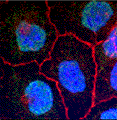Biochemistry, Department of
Document Type
Article
Date of this Version
2011
Citation
The Journal of Biological Chemistry, VOL. 286, NO. 12, pp. 10137–10146, March 25, 2011
Abstract
Saccharomyces cerevisiae cells lacking Mne1 are deficient in
intron splicing in the gene encoding the Cox1 subunit of cytochrome
oxidase but contain wild-type levels of the bc1 complex.
Thus, Mne1 has no role in splicing of COB introns or expression
of the COB gene. Northern experiments suggest that splicing of
the COX1 aI5β intron is dependent on Mne1 in addition to the
previously known Mrs1, Mss116, Pet54, and Suv3 factors. Processing
of the aI5_ intron is similarly impaired in mne1∆ and
mrs1∆ cells and overexpression of Mrs1 partially restores the
respiratory function of mne1∆ cells. Mrs1 is known to function
in the initial transesterification reaction of splicing. Mne1 is a
mitochondrial matrix protein loosely associated with the inner
membrane and is found in a high mass ribonucleoprotein complex
specifically associated with the COX1 mRNA even within
an intronless strain. Mne1 does not appear to have a secondary
function in COX1 processing or translation, because disruption
of MNE1 in cells containing intronless mtDNA does not lead to
a respiratory growth defect. Thus, the primary defect in mne1∆
cells is splicing of the aI5β intron in COX1.
Included in
Biochemistry Commons, Biotechnology Commons, Other Biochemistry, Biophysics, and Structural Biology Commons



Comments
© 2011 by The American Society for Biochemistry and Molecular Biology, Inc.